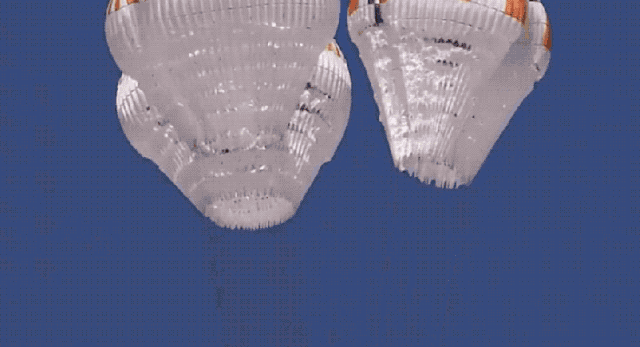SpaceX's Crew Dragon Aces 13th Parachute Test in a Row (Video)
Its chutes are working swimmingly!
SpaceX's Crew Dragon spacecraft has aced yet another critical test.
On Sunday (Nov. 3), SpaceX announced it has completed the 13th successful test in a row of Crew Dragon's parachute system. This most recent demonstration tested how well and how safely the company's new Mark 3 parachutes for the system could land the craft during a parachute failure, the company said in a statement.
"Most recent test demonstrated the parachute system's ability to land the spacecraft safely in the unlikely event that one of the four main parachutes fails," SpaceX representatives said.
During the test, which can be seen in the video above that SpaceX shared on Twitter, the company attempted to land the craft with its fourth parachute intentionally not deploying, to mimic a real-life parachute failure.
"Great work by SpaceX Dragon team & Airborne!," SpaceX founder and CEO Elon Musk wrote on Twitter Monday (Nov. 4). "To be clear, we've only done 1 multi-parachute test of Mk3 design, so 9 more left to reach 10 successful tests in a row."
More: Parachutes, Abort Engines Key Challenges for SpaceX's Crew Dragon
Related: SpaceX's Crew Dragon Demo-1 Test Flight in Pictures
SpaceX team has completed 13 successful tests in a row of upgraded Mark 3 parachutes for Crew Dragon. Most recent test demonstrated the parachute system’s ability to land the spacecraft safely in the unlikely event that one of the four main parachutes fails. pic.twitter.com/VJzDeS8UAGNovember 3, 2019
These 13 tests have surpassed SpaceX's goal of 10 before the end of the year, which SpaceX Founder Elon Musk set for the company last month. "We certainly want to get ... at least on the order of 10 successful tests in a row before, before launching astronauts," Musk said in a press conference with Jim Bridenstine last month, which Bridenstine posted to Twitter. "So that seems like where the behavior of the parachutes is consistent, is across 10 successful tests."
Breaking space news, the latest updates on rocket launches, skywatching events and more!
With all of this testing, the parachutes have been improved in a number of ways. It's visibly obvious that they've been modified, as their once relatively simple, striped appearance has changed and the parachutes now look almost like large jellyfish in the sky.
This changed appearance can at least be partially attributed to the use of Zylon, a specialized polymer, in place of nylon on the parachute lines. The material, developed by researchers at Stanford University, is stronger than nylon and is used in the straps on the latest model of the parachutes. In addition to this new material, the parachutes are also sporting new stitching patterns in the fabric.
Failures and futures
Prior to these recent, successful tests, Crew Dragon's parachutes have suffered from difficulties and failure. In May, the company completed a similar test in which the capsule deployed only three of its four parachutes to see if they would be able to safely land the craft in case the fourth failed in a "real" landing scenario.
Unfortunately, "the test was not satisfactory," Bill Gerstenmaier, then NASA associate administrator for human exploration and operations, said at a hearing of the House Science Committee's space subcommittee on NASA's exploration plans. "We did not get the results we wanted, but we learned some information that's going to affect, potentially, future parachute designs."
In the May test, "the three remaining chutes did not operate properly," he added. Because of this, the test craft hit the ground harder than it should have and sustained damage.
While SpaceX has moved past its earlier chute failures and is currently exceeding its expectations for parachute testing in 2019, the company still has a few boxes to check before its first crewed Demo-2 test with the vehicle, which the company aims to complete early in 2020.
SpaceX still needs to successfully complete static fire tests with the Crew Dragon's abort engine. While it might seem like a routine next step, an uncrewed capsule exploded during the same test just a few months ago in April.
"The initial tests completed successfully but the final test resulted in an anomaly on the test stand," a SpaceX representative told Space.com at the time. The company later said a faulty valve led to the explosion and corrective measures are in place.
Editor's note: This story was updated on Nov. 5 to include a statement from SpaceX CEO Elon Musk.
- SpaceX's Crew Dragon Demo-1 Test Flight in Pictures
- SpaceX's Starship Project Not Affecting Crew Dragon Flights for NASA
- SpaceX Fires Up Rocket in Prep for 1st Astronaut Launch (Photo)
Follow Chelsea Gohd on Twitter @chelsea_gohd. Follow us on Twitter @Spacedotcom and on Facebook.

Chelsea “Foxanne” Gohd joined Space.com in 2018 and is now a Senior Writer, writing about everything from climate change to planetary science and human spaceflight in both articles and on-camera in videos. With a degree in Public Health and biological sciences, Chelsea has written and worked for institutions including the American Museum of Natural History, Scientific American, Discover Magazine Blog, Astronomy Magazine and Live Science. When not writing, editing or filming something space-y, Chelsea "Foxanne" Gohd is writing music and performing as Foxanne, even launching a song to space in 2021 with Inspiration4. You can follow her on Twitter @chelsea_gohd and @foxannemusic.

